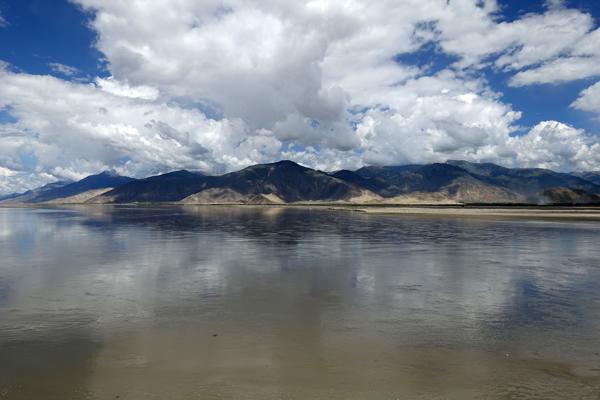
Stunning scenery along the Yarlung Zangbo River in the Tibet autonomous region.[Photo by Wang Zhuangfei/China Daily]
Sitting in an office at the ecological institute she founded 30 years ago, Xu Fengxiang recalled the night she unwittingly found herself surrounded by a pack of hungry wolves in the wilderness.
It was 1993, and the ecologist was leading a seven-strong team of researchers in an area called Chang Tang, a vast 5,000-meter-high plateau in the Tibet autonomous region.
The team had covered about 14,000 kilometers, and their month-long research trip was almost at an end as their vehicles, an SUV and a supply truck, drove through a wilderness of rolling alpine steppes studded with sand dunes, saline lakes and wetland.
“Night was falling. As we drove we suddenly saw flickers of light, red and green, a few hundred meters ahead. We thought they indicated human activity,” Xu recalled, during a recent visit to the Tibetan Plateau Ecology Institute in Nyingchi prefecture, which she founded in 1995.
The red-green flashes turned out to be the eyes of more than a dozen adult wolves, but by the time ecologists realized the danger the howling pack had already surrounded them.
“The moment my driver rolled down the window and aimed a gun at the wolves, I stopped him and shouted three instructions-turn on both rear and front lights, sound the horn and drive forward at a slow speed,” said Xu, who was the team’s only female member.
Thankfully, the wolves backed away, and Xu and her relieved team, fearful of a night on the freezing plateau, were able to continue on their journey.
Proving a point
Recalling the incident after 23 years, the 84-year-old, who is a legend in Chinese ecological circles, said it had been memorable, not because of the fear the wolves inspired, but the fact that the pack had been seen in an area that had been classified as being devoid of life.
“It proved a point I was trying to make-that there are active lives, including wolves, Tibetan gazelles, snow leopards and various types of plants-in the so-called lifeless zone,” Xu said.
A year later, at Xu’s urging, the vast area was designated as nature reserve, with an area covering 247,000 sq km, the second-largest in the world.
As an ecologist, Xu is known to hold a maverick view of the relationship between humans and nature. She insists that human beings are simply a strand in the ecosystem and their status is no higher or lower than that of the other plant and animal with which they coexist.
“Man is nothing but one tiny biotic component in the entire ecosystem, and should place himself at the mercy of nature rather than seek power over it at its source,” she said.
Her love affair with nature started in early childhood and has been central to her life ever since.
Love turned into obsession in 1978 when the then-47-year-old forest ecology university teacher bid farewell to her family in Nanjing, in the eastern province of Jiangsu, and headed for the Tibetan plateau to begin research into what she calls the four high-altitude ecosystems-glaciers, water, grasses and forests, which are all effected by the harsh conditions, high altitudes, extreme winter cold and low oxygen levels that can result in aridity and desertification.
In the 18 years that followed until her retirement, Xu’s footprints covered 130,000 km and more than 20 virgin forests in Tibet as she conducted field research. She visited base camp at Qomolangma, the world’s highest mountain, known in the West as Mount Everest, three times, at ages 61, 70 and 78.
‘China’s Jane Goodall’
Located in Nyingchi’s Bome county, the Gangxiang Spruce Forest covers an area of 46 sq km, more than 61 percent of which is covered by spruce trees.
Without a seven-year field study that Xu conducted in the 1980s the forest would not have been measured and designated a nature reserve as a protection measure. In 2005, it was ranked by China National Geography Magazine as one of the country’s “Top 10 Most Beautiful Forests”.
“She is China’s Jane Goodall,” said Yang Ling, an environmental enthusiast in Beijing.
“Like Goodall who devoted her life to the study of wild chimpanzees and the environmental cause, Xu spent more than 60 years on ecological studies, and in her later years she has specialized in Tibetan ecology and has helped to establish a number of nature reserves,” he said.
In the past 12 or so years, Xu has published 11 academic books, introductions to the distribution of wild flowers, mountains, valleys, rivers and forests in Tibet.
Xu’s recent trip to Nyingchi was her last because the low level of oxygen at high altitude can be detrimental to the health of seniors, and she has reluctantly conceded defeat. “It is really so hard to say goodbye,” she said, as tears welled in her eyes.
“I bid farewell to the plateau many times since my retirement in 1995, but I flew back from Beijing again and again because of my love of nature and this landscape.”
She has now been tasked with educating the younger generation about Tibet’s fragile ecology and the need for protection. “I deliver lectures to students about 10 times a year, and introduce all the Tibetan species to them,” she said.
“I’m happy to be a ‘scientific preacher’ for Tibet until the day I die-urging my fellow humans to protect the species on the plateau.”
